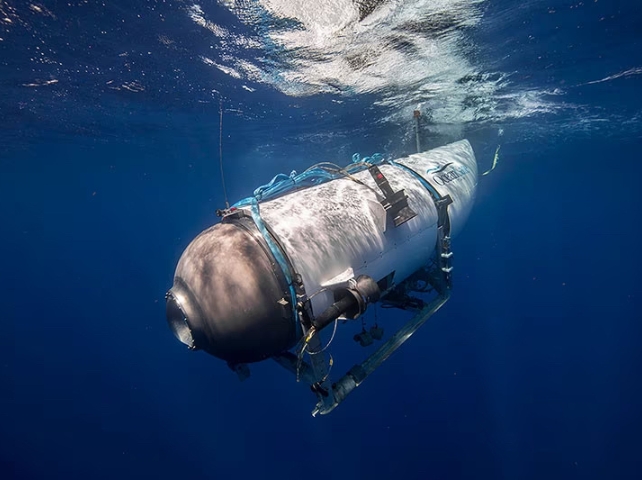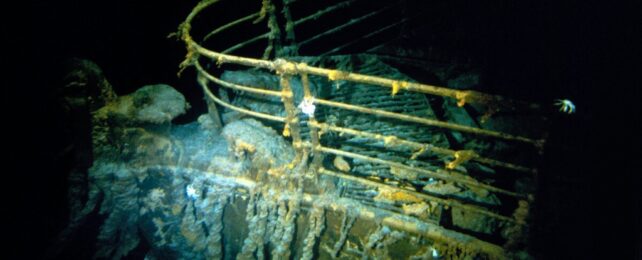The US Coast Guard said late Monday that its search for a missing submersible vessel near the Titanic wreck had been completed for the day, but that a national guard unit and the company operating the five-passenger underwater mission would continue scouring the surface overnight.
The 21-foot (6.5-meter) craft, operated by OceanGate Expeditions, began its descent on Sunday but lost contact with the surface less than two hours later, according to authorities.
The US Coast Guard said it had launched two planes to survey the remote area in the North Atlantic, while its Canadian counterparts had also sent a plane and a ship.
But with no reported sightings of the vessel or communication signals throughout the day, the US Coast Guard's Boston-based unit said in a tweet around 9:00 pm (0100 GMT Tuesday) that its flights for the day "have been completed."
"The Polar Prince and @Rescue106 will continue to do surface searches throughout the evening," the tweet said, referring to the research ship that launched the submersible, and a US Air National Guard unit, respectively.
Searches by Canadian aircraft, which had been using buoys to scan underneath the surface, will continue Tuesday morning, it added.
One of the passengers on board has been identified as British businessman Hamish Harding, whose aviation business had posted on social media about his expedition.
"It is a challenge to conduct a search in that remote area, but we are deploying all available assets to make sure that we can locate the craft and rescue the people on board," US Coast Guard Rear Admiral John Mauger told reporters in Boston, where he was overseeing the operation.
Time is a critical factor. The vessel has a range of 96 hours for the crew of five, and Mauger said Monday afternoon he believed it still had 70 or more hours of remaining oxygen.
OceanGate Expeditions' spokesperson told AFP late Monday that "for some time, we have been unable to establish communications with one of our submersible exploration vehicles which is currently visiting the wreck site of the Titanic."
"Our entire focus is on the wellbeing of the crew and every step possible is being taken to bring the five crew members back safely," the statement added.

The company uses a submersible named Titan for its dives to a maximum depth of 4,000 meters (13,100 feet).
Harding, a 58-year-old aviator, space tourist, and chairman of Dubai-based Action Aviation, had posted Sunday on Instagram that he was proud to join the OceanGate Expedition for their RMS TITANIC Mission as a mission specialist going down to the Titanic.
"A weather window has just opened up and we are going to attempt a dive tomorrow," Harding wrote.
"The team on the sub has a couple of legendary explorers, some of which have done over 30 dives to the RMS Titanic since the 1980s," he added.
Action Aviation posted Sunday on Twitter that "the sub had a successful launch and Hamish is currently diving," and included several photographs of Harding and mission staff on the ocean surface.
RMS TITANIC EXPEDITION 2023
— Action Aviation (@actionaviation) June 18, 2023
4am start this morning on the RMS Titanic Expedition Mission 5 with @oceangateexped. The sub had a successful launch and Hamish is currently diving.
Stay tuned for further updates!
@the_explorers_club @ActionAviation0 #titanic #titansub #discovery pic.twitter.com/qVGoYeHVwd
Clock is ticking
The Titanic hit an iceberg and sank in 1912 during its maiden voyage from England to New York with 2,224 passengers and crew on board. More than 1,500 people died in the tragedy.
The wreckage is in two main pieces 400 miles off the coast of Newfoundland, Canada, some 13,000 feet underwater. It was found in 1985 and remains a source of fascination and a lure for nautical experts and underwater tourists.
Without having studied the craft itself, Alistair Greig, professor of marine engineering at University College London, suggested two possible theories based on images of the vessel published by the press.
He said if it had an electrical or communications problem, it could have surfaced and remained floating, "waiting to be found."
"Another scenario is the pressure hull was compromised – a leak," he said in a statement. "Then the prognosis is not good.
While the submersible may still be intact during its dive, there are very few vessels able to go to the depth to which the Titan might have traveled.
OceanGate said in its statement it was "deeply thankful for the extensive assistance we have received from several government agencies and deep sea companies in our efforts to reestablish contact with the submersible."
"The clock is ticking, and any submariner/submersible deep divers know how unforgiving the Abyssal domain is: going undersea is as, if not more, challenging than going into space from an engineering perspective," said University of Adelaide associate professor Eric Fusil in a statement.
